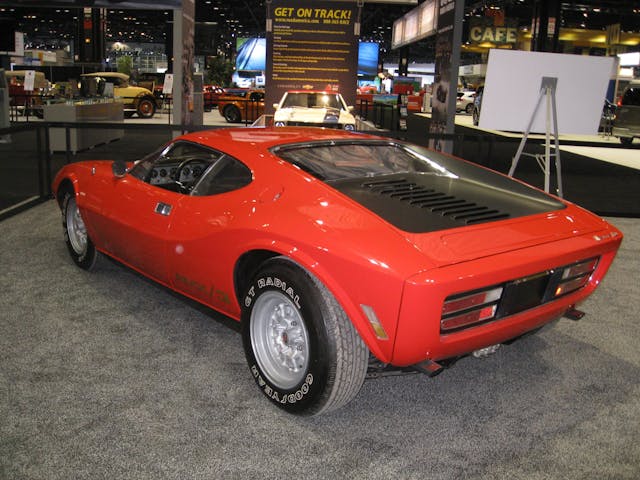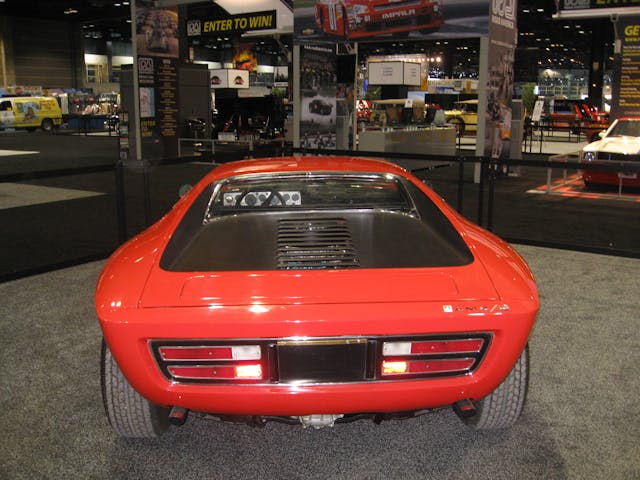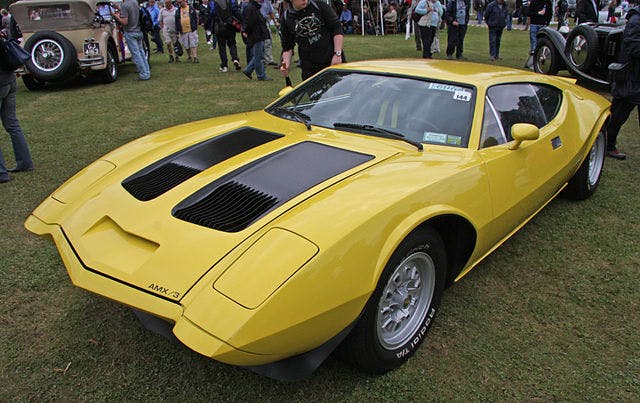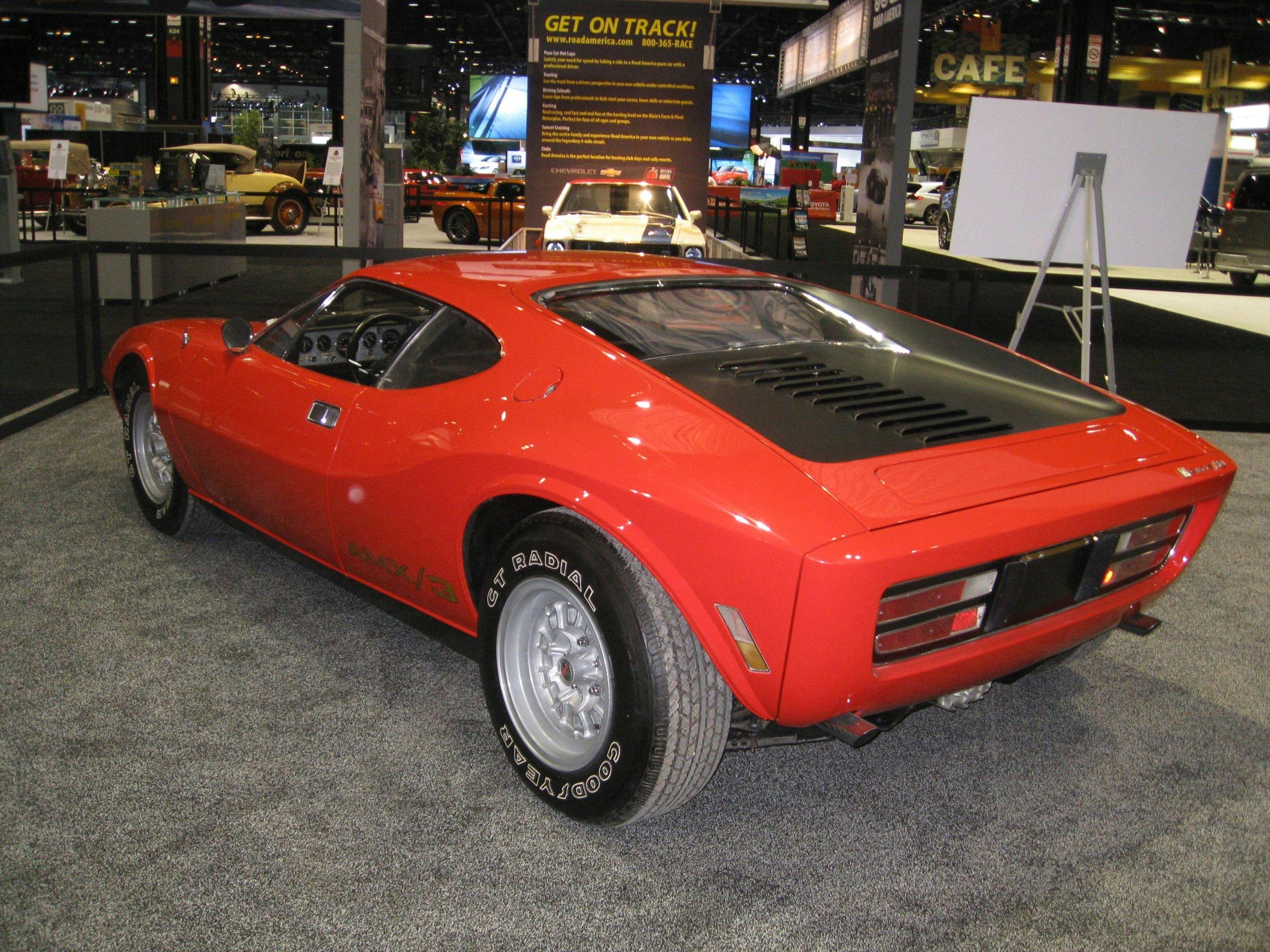Media | Articles
AMX/3: 50 years before the C8 Corvette, AMC built a mid-engine supercar
More than a half century before the mid-engine C8 Chevrolet Corvette, an American automaker made an exotic mid-engine sports car. It was powered by an American V-8 and sported Italian bodywork. No, I’m not talking about the Pantera that De Tomaso made for Ford, I’m talking about plucky little American Motors Corporation and its head designer Dick Teague’s pride and joy, the AMX/3, designed two years before the Pantera. While the AMX/3 never quite made it to serial production, six cars were built and at least from a mechanical standpoint it was fully engineered. It has a great story, perhaps one of Detroit’s greater tragedies, and like all great tragedies, the characters and cast were notable.
The story starts in 1962, when George Romney, who successfully positioned AMC as the maker of the economical compact Rambler in juxtaposition to the Big 3 automaker’s full lines and profitable big cars, resigned from the company to start a career in politics, running for governor of Michigan. Romney was replaced by Roy Abernethy, a physically large man who wasn’t fond of small cars. Abernethy abandoned Romney’s strategy and spent millions of dollars on AMC’s larger cars, trying to compete segment for segment with GM, Ford, and Chrysler. While some of that money was well spent on developing a modern V8 engine that could be made in both small- and large-block displacements, a lot of it was wasted on an all-new full-sized Ambassador and the disappointing midsize Marlin fastback.
The Marlin had a fastback roofline not unlike the very successful 1966 Dodge Charger. The problem was that while the Charger looked sleek, the Marlin looked a little awkward. That’s because Richard Teague had intended that roofline to go on a smaller car. Abernethy instead had it moved to the midsize platform, which resulted in odd proportions and not much in terms of sales success.
After just five years, Abernethy put a profitable company in the red, and likely planted the seeds of the company’s eventual demise by putting it in such a precarious financial situation.

The board stepped in, forced Abernethy into retirement and installed Roy D. Chapin Jr., whose father once ran Hudson, as chairman and Gerald C. Meyers, just 39 at the time, as VP of product development and manufacturing. Chapin and Meyers wanted a more youthful, performance-oriented image, using the Javelin pony car and related AMX two-seater already in development as a foundation. They went racing with Roger Penske and Mark Donohue, made the outrageous The Rebel Machine muscle car, and in May of 1967 they commissioned Richard Teague and his chief designer Bob Nixon to build a mid-engine sports car. The fiberglass ‘pushmobile’ concept they came up with was dubbed the AMX/2 and AMC’s management was impressed enough to go forward with the project. AMC forecast sales of about 1000 AMX/3 cars a year (some sources say 5000), undoubtedly the kind of halo car Chapin and Meyers were looking for.
Marketplace
Buy and sell classics with confidence

Impressed as they were, though, AMC execs weren’t confident that Teague’s in-house team was up to the task so they insisted on a design competition between the team in Detroit and Italian Giorgetto Giugiaro, then a rising star in the automotive design world, having recently co-founded ItalDesign after working for Bertone. In the spring of 1968, Teague and Meyers met with Giugiaro at the Geneva Motor Show to give him the design brief.
Teague took the competition seriously, and decided to improve the design. What became the AMX/3 was designed by a team that included stylists Bob Nixon, Jack Kenitz, Eric Kugler, Dick Jones and Gary Guichard along with invaluable work by clay modelers Chuck Hosper, Keith Goodnough and Howard Clark. When they presented their fully developed fiberglass mockup, it put the relatively crude styrofoam concept ItalDesign submitted to shame, and the in-house AMX/3 was greenlighted for development. Small wonder as the AMX/3 is simply gorgeous.
That didn’t end Giugiaro’s involvement with the AMX/3 though.
From the outset, management at AMC knew that production of a limited edition sports car was going to have to be outsourced. The factory in Kenosha certainly wasn’t up to it.
At first Karmann was considered. The German firm already was assembling CKD (completely knocked down) kits of AMC Javelins for sale in Europe. AMC was also discussing other projects with BMW, then a much smaller company than it is now, but when AMC approached them about engineering the AMX/3, the Bavarian automaker declined, saying they didn’t have the needed two or three dozen engineers to spare for the project. In one version of the story, upon the recommendation of Renzo Carli, managing director of Pininfarina at the time, AMC gave the job to Giotto Bizzarrini in late 1968. Bizzarrini spent five years as Enzo Ferrari’s chief engineer at the peak of his racing teams success in the late 1950s and was one of the five Ferrari engineers who left Enzo in 1961 to start the ill-fated ATS racing team. Later he started his own firm, Bizzarrini SpA, whose bankruptcy made him available to work on the AMX/3.
As good of an engineer as Bizzarrini was, he was just one man, not 30 so additional contractors were brought in to meet the proposed start of testing in mid 1969. Additionally, Bizzarrini was an engine and suspension guy who didn’t have much experience designing unibody structures, as the AMX/3 was planned to be. So Giugiaro’s ItalDesign was brought in at least to develop and test the AMX/3’s unibody, and quite possibly do much of the production engineering, though who did what is unclear. For his part, Bizzarrini was proud of his work, saying. “I would have to say the AMX/3 was the best car I built in terms of mechanical components and roadholding.”
According to Salvatore Diamonte, whose Autocostruzioni SD did much of the fabrication work on the prototypes, it was Karmann that was supposed to build the cars, and they commissioned ItalDesign to manage the project, and ItalDesign in turn brought in Bizzarrini to design the chassis. In a 1983 interview, Diamonte said that he delivered two bodies to ItalDesign to work out the blueprints for stamping dies. Later he and Bizzarrini fitted mechanical parts and completed those two prototypes powered by 390 cubic inch AMC V8s. Other stock production AMC parts used included dashboard switchgear and AMC’s ubiquitous flush-mounted flip out exterior door handles.
Though BMW had originally declined to engineer the AMX/3 for American Motors, the two companies were still looking to cooperate. BMW was considering having the BMW 2002, then in high demand, produced in North America and AMC had production capacity available. In the spring of 1969, AMC and BMW inked a 1.5 million DM contract for the German company to test the AMX/3 prototypes and verify their performance, including a target top speed of 160 mph. At some point, however, BMW transitioned from simply testing the cars to developing them.
Prototype #1 proved to be a bit of a flexible flyer. Lower frame rails flexed so much that it affected suspension and steering geometry. Seams burst and welds broke. Improvements were made and prototype #2 proved to be 50% stiffer. When the brakes also proved to be on the soft side BMW brought in German brake manufacturer Alfred Teves (ATE) to replace the original Girling components with upgraded master cylinder, vacuum boosters, calipers and rotors. BMW also improved the hydraulic clutch operation and had Boysen GmbH develop a custom exhaust system to fit in the little bit of space available due to the short wheelbase and mid-engine configuration. For his part, Bizzarrini convinced his previous employer OTO Melara to develop a custom transaxle as the more commonly used ZF unit was too long to fit.

Overheating was also a problem as the AMX/3’s attractive front end didn’t allow for much airflow to the radiators, but in time the #2 car was successfully tested at speed at Monza in the spring of 1970. The AMX/3 was introduced to the press in Rome in March of that year, with a public introduction at the New York Auto show in April. Racer Mark Donohue put one of the prototypes through its paces at Michigan International Speedway.
A total of nine chassis were constructed, with six cars more or less completed at the time. There are differences between the six, reflecting the development process.
By the time the AMX/3 was introduced, though, it’s likely that AMC had already killed the project despite overwhelmingly positive response from the public and press. At a reported target price of $12,000 in the early 1970s, a couple thousand dollars more than the Pantera when it was introduced, it would have been a hard sell. With a limited run of just 1,000 units, later scaled down to a couple dozen cars a year, the financial case for the AMX/3 just wasn’t there. To give some context, even Ford Motor Company, with substantially more resources than little AMC, wasn’t able to keep the Pantera on the market for more than four years. selling just 5,500 units in that time frame.
AMC continued partial funding while Giotto Bizzarrini considered producing the AMX/3 as the Sciabola (Italian for sabre), with AMC supplying components, but none were ever built. “I just didn’t have the courage to proceed,” he said. By the time AMC pulled the plug, they had invested about $2 million, about $15 million in today’s dollars. While that wasn’t a huge sum by Big 3 standards, AMC didn’t have much cash to spare. By comparison, less than 10 years later, AMC spent about $6.5 million developing what many people consider to be the first crossover, the Eagle 4×4, which actually earned the company revenue, unlike the AMX/3 project.
Fortunately, though the project was not a financial success, all six of the original AMX/3 cars still exist as do the AMX/2 and AMX/3 pushmobiles. A seventh chassis was finished with leftover parts and that still exists as well. Provenance of all the cars has been documented, though there are some discrepancies in the sources.
AMX/3 #1: Sent to BMW for testing in mid 1969. Later stripped of parts for other prototypes. Purchased by the Dawkins family in the 1970s, without a drivetrain or major components. Recently purchased by Michael Chetcuti and Kyle Evans of Northport, Michigan, family friends of the Dawkins. The car is currently undergoing a full restoration and refitting, which you can follow here.
AMX/3 #2: Monza test car assembled in 1969, tested at Monza in 1970. Sold to Jerry Werden in 1971 for $6,000 and has changed hands a number of times since then. Currently owned by Rick and David Biafora of Morgantown, Virginia. Apparently it was tagged as a 1967 model to get around DOT regulations at the time it was imported.
AMX/3 #3: This car was used at the Rome press introduction in March 1970. This was the only car of the six to be fully finished to presentation levels and the only one to be imported to the U.S. by AMC before the project was killed. It was revealed to the American media at the Waldorf hotel in Manhattan in early April, while the fiberglass pushmobile went on display the next day at the New York Auto Show. In 1978, Dick Teague bought number 3 from AMC, along with #1 and #5. Number three is still in the possession of Teague’s daughter Lisa and her husband Ray Scarpelli and it’s the red car in the photos accompanying this article.
AMX/3 #4: Painted teal-blue, this car was finished to show quality by Diomante and Bizzarrini for the Turn auto salon in the fall of 1970. Considered the production prototype, it was the first to have a revised body including four inch longer rear quarter panels, bigger fender flares, full side glass, semi-concealed windshield wipers with a raised cowl, and different hood vents for the radiator. It also lost the active, pop-up rear spoiler, a novel feature that wouldn’t show up on production cars for decades. Number 4 and number six had the smaller 360ci V-8 installed, possibly for budget reasons or because by then the 390 had ceased production but the 401 wasn’t yet available. Purchased for $9,000 by Jerry Werden and Bill Demichielli in 1971, according to one source it remained in Werden’s possession until his death in 2018 and was sold to an anonymous collector who bought it from the Werden trust in 2020. Hemmings, though, has Demichielli selling #4 in 1976, with it later passing into the possession of Walter Kirtland of Baton Rouge, Louisiana, in 1989, who subsequently sold it to a German collector in 2014.

AMX/3 #5: Though it was constructed simultaneously with numbers 4 and 6, this car has the older body style and was assembled using leftover parts. After Teague bought it in 1978, he installed upside down 1979 Firebird taillights and had it painted Big Bad Yellow. Teague sold it to George Doughtie Jr, who described it as an “orphan car,” “not driveable,” and “rough, cobbled-up” with just 200 miles on the odometer when he bought it. Number 5 last changed hands in 2004 when it was purchased by Bernie and Joan Carl of Washington DC.

AMX/3 #6 was finished in late 1970 or early 1971 after AMC pulled the project funding but much of it was done when AMC was still paying for things, hoping that Bizzarrini would get the Sciabola going. Teague considered it the nicest of the six, “The fairest one of all. It is a real gem,” he told Automobile Quarterly in 1981. Painted red, and funded by OTO Melara it was displayed at the ’76 Turin show to promote the Sciabola project, expected to cost “at least $23,800” for “hand-built” examples according to a Bizzarrini interview at the time. At $122,000 in 2022 dollars, that sounds like a bargain considering one of the prototypes was advertised for sale in 2013 at $795,000. Number six remained in the possession of Salvatore Diomonte until earlier this year, when he was reported to have sold it to a Netherlands collector.
So that’s the story of the AMX/3. It could’ve been a contender and had an all-star cast behind it, but some things are just not meant to be. Fortunately, in addition to the story, we still have the cars.

















With my Dad as an employee of AMC-Milwaukee, and my own stint at selling AMC high performance vehicles for model years 1969 & 1970, I truly got into your story about the AMX/3. I remember the hype around it. For me, I am still a great fan of AMC products despite the demise of the company.
I remember the laughs I got when I was the first guy in Milwaukee county to equip my 1963 Rambler Classic 550 with Mickey Thompson mag wheels, add a simple red pin stripe on both sides of my black car, and make the car look “hot” despite it only having a 199cid 6-cylinder. I would own 3 more AMC, but I sure had fun with all of them.
Keep bringing us great stories of the “no longer existing firms and their hot cars.” It makes for great memories of bygone days.
Great summation. I owned a ’69 AMX back in the day, so I always followed the AMX/3 over the years. I’ve seen one (#3) in person years ago. Stunning design. AMC and its management had a great idea. So did Ford with the Pantera. The amx390.com website is a good resource for more info, if you want to take the proverbial deep dive. Cheers!